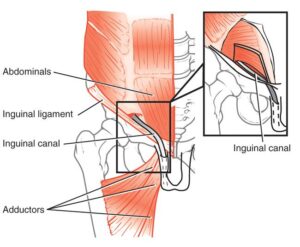After exiting the Week One home opener versus the San Francisco 49ers with a groin injury, DT Cam Heyward, the anchor of the defensive line and heart of the defense, was unable to return to play despite a valiant effort. Over the next 48 hours, there were conflicting reports as to whether he would require surgery for the injury. Steelers fans got clarity on Tuesday from Head Coach Mike Tomlin during his weekly press conference, when he confirmed that Heyward would indeed undergo surgery. Several NFL insiders estimate that he will be out for eight weeks, making a roster move to IR with a designation to return inevitable.
On a segment during “The Insiders” on NFL Network, Mike Garafolo referred to the injury as a “sports hernia,” immediately correcting himself to describe it as a core muscle injury. Garafolo also confirmed the eight-week recovery time frame.
So what, exactly does all of this mean from a surgical standpoint? Let me explain. It’s not the first time we have talked about the dreaded sports hernia, more accurately known as athletic pubalgia or a core muscle injury, with regard to Steelers players. I reviewed the topic back in 2016 when OLB Bud Dupree was sidelined during the entire preseason, only to undergo surgery as the season opened. Dupree’s situation was a little different — the team gave him weeks to improve, hoping he might avoid surgery altogether, which eventually didn’t work out. In an interview three weeks after his surgery, Dupree revealed that he had been dealing with the injury since April of that year. He eventually made his return in late November, 11 weeks post-op.
Fortunately, surgical techniques improve over time, even for the surgeon who is considered the expert, Dr. William Meyers, who is based in Philadelphia and treats this injury for a majority of NFL players. I would guess that is where Heyward headed for his second opinion and most likely for surgery as well. For more chronic injuries, like Dupree had, a trial of non-operative management is usually the first line of treatment, including physical therapy, injections, acupuncture, anti-inflammatory medications, massage therapy, and even yoga. According to Meyers and other medical studies, however, early surgical intervention for acute or severe injuries can return players to their pre-injury level of performance faster. And that is obviously the situation for Heyward.
As Meyers describes on his website:
“An open surgical procedure for repairing the pelvic floor, such as how the surgeons at Vincera Institute perform them, consists of the reattachment of the rectus abdominis muscles (your “abs”) to the pubic bone. If athletes have adductor involvement, an adductor compartmental decompression and/or repair could be done. To directly treat the inflammation, the procedure involves the anterior and lateral release of the epimysium of the adductor fascia, the connective tissue that ensheaths the adductor muscles.”
Let’s look at the muscles he is typically repairs:
The damage in a core muscle injury usually involves the abdominal muscles where they attach to the pubic bone, most commonly the oblique muscles. The adductor muscles of the medial thigh can also be torn, as I explained when the injury was first characterized as a groin injury.
The surgery can be performed through an open incision or as an endoscopic procedure, with small incisions and a telescope. During the procedure, the torn muscles are reattached to the ligaments and the pubic bone to recreate the normal anatomy and reestablish stability in the joint. Unlike a traditional hernia repair, which is an entirely different anatomic defect, no prosthetic mesh is used. Here is a video showing an open repair. In this video, the adductor muscle is also repaired. This video shows an endoscopic repair of an adductor longus muscle tear (skip to 30 seconds into the video if you’re at work). Most NFL players and other professional athletes undergo open repair.
The recovery from this procedure is pretty standard, starting with walking, progressing to a stationary bike and weight lifting and eventually to straight-line running. Once the athlete can perform these activities, he will eventually return to football activities, including lateral movements and the other moves a defensive lineman must perform.
There is every reason to expect that Heyward will return to his Pro Bowl form this season. In a 2017 review of NFL players undergoing surgery for core muscle injuries published in the Orthopaedic Journal of Sports Medicine, 100 percent of the defensive linemen returned to play and there was no drop-off in performance from a statistical standpoint.
And if Heyward needs inspiration, he only needs to look as far as Philadelphia, to Eagles OT Lane Johnson. Just one year younger, Johnson sustained an adductor tear late in the 2022 season. He missed the remaining two regular-season games but returned for the team’s playoff run, playing every offensive snap in the Super Bowl. Johnson confirmed that Dr. Meyers was his surgeon and underwent repair of both groins on Feb. 16, 2023:
Johnson’s recovery was clearly going well just five weeks later, when he signed a one-year extension worth $33.445 million with $30 million guaranteed to keep him under contract through 2026. He was cleared to return to full participation prior to OTAs last spring.
Obviously, losing Cam Heyward for eight weeks could be devastating for a defensive unit that clearly struggled in the absence of teammate and former Defensive Player of the Year outside linebacker T.J. Watt last season. It will certainly be next man up, and perhaps next generation up, until he can return. The good news is that when Heyward does return, he should be performing at the same level as prior to his injury and can resume wreaking havoc on opposing offenses.
“Melanie H. Friedlander, M.D., F.A.C.S. is a board-certified general surgeon at the Association of South Bay Surgeons in Torrance, California. She has developed and published many scientific studies in highly esteemed medical journals.”









